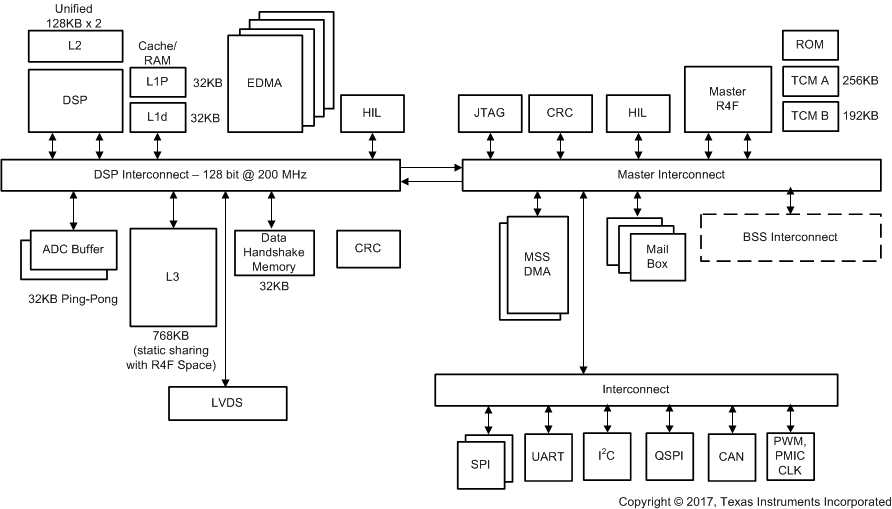ZHCSH27B May 2017 – April 2018 IWR1642
PRODUCTION DATA.
- 1 器件概述
- 2 修订历史记录
- 3 Device Comparison
- 4 Terminal Configuration and Functions
-
5 Specifications
- 5.1 Absolute Maximum Ratings
- 5.2 ESD Ratings
- 5.3 Power-On Hours (POH)
- 5.4 Recommended Operating Conditions
- 5.5 Power Supply Specifications
- 5.6 Power Consumption Summary
- 5.7 RF Specification
- 5.8 CPU Specifications
- 5.9 Thermal Resistance Characteristics for FCBGA Package [ABL0161]
- 5.10
Timing and Switching Characteristics
- 5.10.1 Power Supply Sequencing and Reset Timing
- 5.10.2 Input Clocks and Oscillators
- 5.10.3
Multibuffered / Standard Serial Peripheral Interface (MibSPI)
- 5.10.3.1 Peripheral Description
- 5.10.3.2
MibSPI Transmit and Receive RAM Organization
- Table 5-7 SPI Timing Conditions
- Table 5-8 SPI Master Mode Switching Parameters (CLOCK PHASE = 0, SPICLK = output, SPISIMO = output, and SPISOMI = input)
- Table 5-9 SPI Master Mode Input Timing Requirements (CLOCK PHASE = 0, SPICLK = output, SPISIMO = output, and SPISOMI = input)
- Table 5-10 SPI Master Mode Switching Parameters (CLOCK PHASE = 1, SPICLK = output, SPISIMO = output, and SPISOMI = input)
- Table 5-11 SPI Master Mode Input Requirements (CLOCK PHASE = 1, SPICLK = output, SPISIMO = output, and SPISOMI = input)
- 5.10.3.3 SPI Slave Mode I/O Timings
- 5.10.3.4 Typical Interface Protocol Diagram (Slave Mode)
- 5.10.4 LVDS Interface Configuration
- 5.10.5 General-Purpose Input/Output
- 5.10.6 Controller Area Network Interface (DCAN)
- 5.10.7 Serial Communication Interface (SCI)
- 5.10.8 Inter-Integrated Circuit Interface (I2C)
- 5.10.9 Quad Serial Peripheral Interface (QSPI)
- 5.10.10 ETM Trace Interface
- 5.10.11 Data Modification Module (DMM)
- 5.10.12 JTAG Interface
- 6 Detailed Description
- 7 Monitoring and Diagnostics
- 8 Applications, Implementation, and Layout
- 9 Device and Documentation Support
- 10Mechanical, Packaging, and Orderable Information
6.3.2 Processor Subsystem
 Figure 6-4 Processor Subsystem
Figure 6-4 Processor Subsystem Figure 6-4 shows the block diagram for customer programmable processor subsystems in the IWR1642 device. At a high level there are two customer programmable subsystems, as shown separated by a dotted line in the diagram. Left hand side shows the DSP Subsystem which contains TI's high-performance C674x DSP, a high-bandwidth interconnect for high performance (128-bit, 200MHz) and associated peripherals – four DMAs for data transfer, LVDS interface for Measurement data output, L3 Radar data cube memory, ADC buffers, CRC engine, and data handshake memory (additional memory provided on interconnect).
The right side of the diagram shows the Master subsystem. Master subsystem as name suggests is the master of the device and controls all the device peripherals and house-keeping activities of the device. Master subsystem contains Cortex-R4F (Master R4F) processor and associated peripherals and house-keeping components such as DMAs, CRC and Peripherals (I2C, UART, SPIs, CAN, PMIC clocking module, PWM, and others) connected to Master Interconnect through Peripheral Central Resource (PCR interconnect).
Details of the DSP CPU core can be found at http://www.ti.com/product/TMS320C6748.
HIL module is shown in both the subsystems and can be used to perform the radar operations feeding the captured data from outside into the device without involving the RF subsystem. HIL on master SS is for controlling the configuration and HIL on DSPSS for high speed ADC data input to the device. Both HIL modules uses the same IOs on the device, one additional IO (DMM_MUX_IN) allows selecting either of the two.